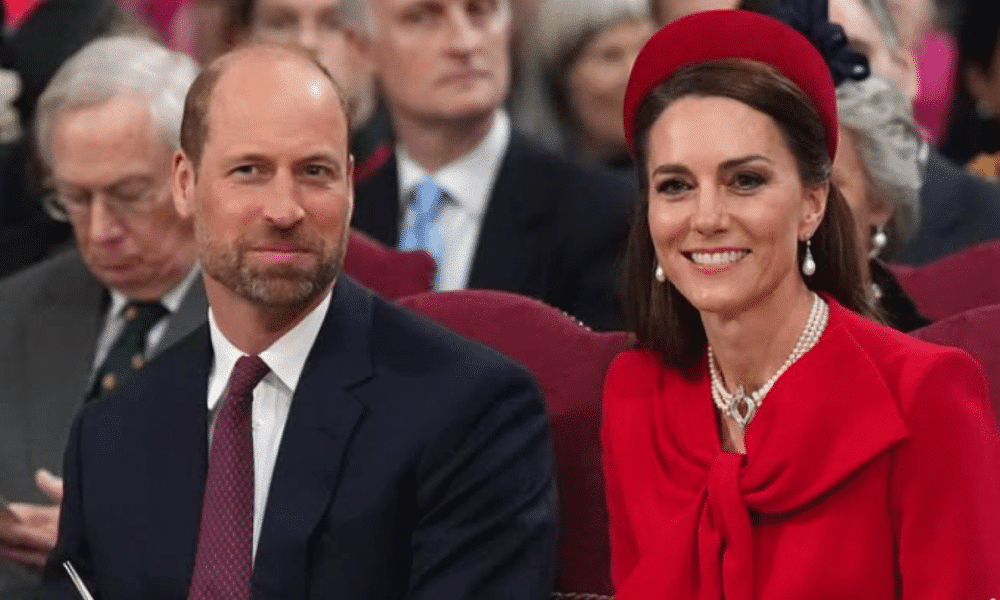The British monarchy stands at a pivotal moment. King Charles III, aged 76, battles a cancer diagnosed in February 2024, which has worsened throughout 2025, severely limiting his public duties. This health crisis propels Prince William, 42, and Kate Middleton, also 42, into central roles as they prepare for a succession that may come sooner than anticipated. Since Charles ascended the throne in September 2022, following the death of Queen Elizabeth II, the Crown has faced challenges testing its endurance. The king’s fragile health, combined with Kate’s own cancer diagnosis in January 2024, places the royal family in a delicate balance between tradition and modernization, with the United Kingdom and 56 Commonwealth nations watching closely.
William has significantly expanded his responsibilities in 2025, taking on roughly 80% of his father’s official duties. He attended over 150 events last year, including international engagements like the reopening of Notre-Dame Cathedral in Paris in December 2024. Additionally, he championed causes such as mental health, raising £20 million for charitable initiatives. Kate, though limited by her treatment, plans a gradual return, with 20 engagements scheduled for 2025, down from her usual 120 in prior years. Charles’s public appearances, which dropped from 200 in 2024 to fewer than 50 this year, reflect the severity of his condition and accelerate preparations for the next generation.
While Buckingham Palace remains tight-lipped about the specifics of the king’s cancer, the disease’s lack of remission fuels speculation about a possible abdication. The monarchy, contributing £1.8 billion annually to the UK economy, faces growing pressure to adapt to a changing world. William and Kate, with a 75% approval rating among Britons, emerge as vital figures in ensuring the Crown’s continuity, balancing traditional duties with modern initiatives that reached millions in 2024.
- Intensive preparation: William and Kate undergo training in diplomacy, estate management, and royal protocols.
- Health in focus: The cancers of Charles and Kate reshape royal family dynamics, reducing public engagements.
- Urgent modernization: The monarchy seeks relevance amid debates over republicanism in the Commonwealth.
King’s health reshapes royal roles
Charles III’s condition, detected after a procedure for benign prostate hyperplasia in 2024, has dramatically altered the monarchy’s operations. He undertook fewer than 10 international trips in 2024, compared to 25 the previous year, prioritizing medical treatments that demand much of his energy. This shift has placed the burden of responsibility on William, who now manages royal estates and charitable institutions. In 2025, the prince handles 80% of the duties once performed by the king, including meetings with global leaders and high-profile events. His ability to maintain stability amid Charles’s health crisis strengthens his position as the future monarch.
Kate faces her own health challenge. Diagnosed with cancer following abdominal surgery in January 2024, she reduced her engagements from 120 in 2023 to just 40 last year. Yet her resolve to resume public duties, with 60 events planned for 2025, showcases resilience. The couple collaborates to bolster the monarchy’s image, with projects benefiting 5 million people in 2024, particularly in areas like early childhood education and sustainability. William and Kate’s popularity, 20% higher than Charles’s, is a critical asset in these uncertain times.
William takes the forefront
William has emerged as the monarchy’s primary representative in 2025, with a schedule reflecting the intensity of his preparation for the throne. He held over 20 meetings with foreign policy experts and led 10 international trips last year, solidifying his diplomatic experience. His mental health initiatives also achieved significant impact, raising £20 million for programs that reached millions of Britons. William’s ability to balance traditional duties with contemporary causes has boosted his public approval to 75%, compared to Charles’s 50%, according to recent polls.

Kate complements these efforts, despite her treatment constraints. Her educational projects, which supported 2 million children in 2024, continue to garner public support, with 70% of Britons viewing her as a relevant figure for the monarchy. Her goal of 60 engagements in 2025, though modest compared to previous years, signals a steady return. Together, William and Kate form a charismatic and committed duo, essential for navigating the challenges of an imminent transition.
The monarchy faces mounting external pressures. Of the 56 Commonwealth nations, 14 still recognize the monarch as head of state, but republican movements are gaining traction. Barbados severed ties with the Crown in 2021, and 10 other countries plan referendums by 2030. The monarchy’s annual cost of £100 million also draws scrutiny, with 40% of Britons questioning its value in 2024. Yet its £1.8 billion economic impact, including £500 million from tourism, underscores its significance.
- Reduced travel: Charles attended fewer than 10 international events in 2024, down from 25 in 2023.
- William’s leadership: He handles 80% of the king’s duties, including estate management.
- Kate’s comeback: With 60 engagements planned for 2025, she reinforces her role as future queen consort.
Modernization amid crisis
The need to modernize the monarchy has never been clearer. William and Kate focus on causes resonating with younger audiences, such as mental health and sustainability, reaching 5 million beneficiaries in 2024. Their initiatives generated £50 million in donations last year, contrasting with perceptions of detachment linked to Charles, whose approval fell to 50% in 2023. The couple’s ability to blend tradition with contemporary demands is seen as a key to preserving the Crown’s relevance.
Meanwhile, Charles’s health continues to restrict his role. He participated in fewer than 50 engagements in 2025, a sharp decline from 200 in 2024. This drop intensifies speculation about the reign’s future, with analysts suggesting that while abdication remains unlikely in the near term, it cannot be ruled out. William, already prepared to ascend, manages assets like the Duchy of Cornwall, generating £20 million annually, and charities that enhance the monarchy’s global presence.
Kate, despite her diagnosis, remains active in early childhood education, with programs aiding 2 million children last year. Her gradual recovery, marked by 15 public events in 2024, symbolizes determination. The couple faces the challenge of keeping the monarchy relevant in a world questioning traditional institutions, with 6 Commonwealth nations debating separation in 2025.
Succession line takes shape
The British succession is increasingly clear:
- Prince William: First in line, ready to assume the throne.
- Kate Middleton: Future queen consort, pivotal in modernization efforts.
- Prince George: At 11, begins attending royal events.
- Princess Charlotte: Second in line, followed by Prince Louis.
- Prince Harry: Fifth, with his children Archie and Lilibet next.
William has taken on 80% of Charles’s duties in 2025, including 10 overseas trips that bolster his global stature. George, the couple’s eldest son, participated in five public events in 2024, signaling his gradual introduction to royal responsibilities. Kate, with 15 engagements in 2024, remains committed despite recovery, cementing her stabilizing role.
Global challenges for the Crown
The monarchy navigates a complex landscape. Its £100 million annual cost sparks debate, particularly amid economic strain. Still, its £1.8 billion economic contribution, with £500 million from tourism, is undeniable. William and Kate counter criticism with tangible action, reaching 5 million people through charity in 2024. Their 75% approval rating contrasts with Charles’s 50%, reflecting public trust in the couple.
Six Commonwealth nations plan to discuss republicanism in 2025, a challenge testing William and Kate’s ability to maintain historic ties. Barbados’s shift to a republic in 2021 sets a precedent inspiring others. Yet the couple’s popularity, 20% above the royal average, may help sustain the Crown’s influence during this transition.
Historical milestones of the monarchy
British history provides context for today:
- 1936: Edward VIII abdicates, passing the throne to George VI.
- 1952: Elizabeth II ascends at 25, reigning for 70 years.
- 2022: Charles III takes the throne at 73, facing immediate challenges.
Charles’s reign, potentially the shortest since Edward VIII, hinges on his health. William and Kate’s preparation reflects the urgency of ensuring a smooth transition, in a context far different from Elizabeth II’s stable era.
Resilience through adversity
Kate’s health adds complexity. Her 2024 diagnosis cut her engagements by 70%, but her target of 60 events in 2025 shows resolve. William, meanwhile, leads with 80% of Charles’s duties, managing assets sustaining the monarchy. Together, they raised £20 million for charity in 2024, with programs aiding 2 million children and enhancing the Crown’s public image.
Charles’s decline, with fewer than 50 engagements in 2025, underscores succession’s inevitability. His 25 international trips in 2023 fell to under 10 in 2024, reflecting treatment priorities. The monarchy, under pressure to evolve, finds in William and Kate a duo capable of facing the future with pragmatism and popularity.
Preparing for a new era
As Charles undergoes intensive treatment, William and Kate solidify their leadership. The prince’s 10 international trips in 2025 and Kate’s 20 planned engagements reflect a joint effort to keep the monarchy relevant. The Crown’s £1.8 billion economic impact, paired with the couple’s 75% approval, provides a strong foundation for transition.
The Commonwealth’s 2.5 billion citizens watch closely, with six nations debating change in 2025. The monarchy, facing its first transition in 70 years, confronts a test of resilience. William and Kate, blending tradition with modernity, hold the key to the Crown’s next chapter.

The British monarchy stands at a pivotal moment. King Charles III, aged 76, battles a cancer diagnosed in February 2024, which has worsened throughout 2025, severely limiting his public duties. This health crisis propels Prince William, 42, and Kate Middleton, also 42, into central roles as they prepare for a succession that may come sooner than anticipated. Since Charles ascended the throne in September 2022, following the death of Queen Elizabeth II, the Crown has faced challenges testing its endurance. The king’s fragile health, combined with Kate’s own cancer diagnosis in January 2024, places the royal family in a delicate balance between tradition and modernization, with the United Kingdom and 56 Commonwealth nations watching closely.
William has significantly expanded his responsibilities in 2025, taking on roughly 80% of his father’s official duties. He attended over 150 events last year, including international engagements like the reopening of Notre-Dame Cathedral in Paris in December 2024. Additionally, he championed causes such as mental health, raising £20 million for charitable initiatives. Kate, though limited by her treatment, plans a gradual return, with 20 engagements scheduled for 2025, down from her usual 120 in prior years. Charles’s public appearances, which dropped from 200 in 2024 to fewer than 50 this year, reflect the severity of his condition and accelerate preparations for the next generation.
While Buckingham Palace remains tight-lipped about the specifics of the king’s cancer, the disease’s lack of remission fuels speculation about a possible abdication. The monarchy, contributing £1.8 billion annually to the UK economy, faces growing pressure to adapt to a changing world. William and Kate, with a 75% approval rating among Britons, emerge as vital figures in ensuring the Crown’s continuity, balancing traditional duties with modern initiatives that reached millions in 2024.
- Intensive preparation: William and Kate undergo training in diplomacy, estate management, and royal protocols.
- Health in focus: The cancers of Charles and Kate reshape royal family dynamics, reducing public engagements.
- Urgent modernization: The monarchy seeks relevance amid debates over republicanism in the Commonwealth.
King’s health reshapes royal roles
Charles III’s condition, detected after a procedure for benign prostate hyperplasia in 2024, has dramatically altered the monarchy’s operations. He undertook fewer than 10 international trips in 2024, compared to 25 the previous year, prioritizing medical treatments that demand much of his energy. This shift has placed the burden of responsibility on William, who now manages royal estates and charitable institutions. In 2025, the prince handles 80% of the duties once performed by the king, including meetings with global leaders and high-profile events. His ability to maintain stability amid Charles’s health crisis strengthens his position as the future monarch.
Kate faces her own health challenge. Diagnosed with cancer following abdominal surgery in January 2024, she reduced her engagements from 120 in 2023 to just 40 last year. Yet her resolve to resume public duties, with 60 events planned for 2025, showcases resilience. The couple collaborates to bolster the monarchy’s image, with projects benefiting 5 million people in 2024, particularly in areas like early childhood education and sustainability. William and Kate’s popularity, 20% higher than Charles’s, is a critical asset in these uncertain times.
William takes the forefront
William has emerged as the monarchy’s primary representative in 2025, with a schedule reflecting the intensity of his preparation for the throne. He held over 20 meetings with foreign policy experts and led 10 international trips last year, solidifying his diplomatic experience. His mental health initiatives also achieved significant impact, raising £20 million for programs that reached millions of Britons. William’s ability to balance traditional duties with contemporary causes has boosted his public approval to 75%, compared to Charles’s 50%, according to recent polls.

Kate complements these efforts, despite her treatment constraints. Her educational projects, which supported 2 million children in 2024, continue to garner public support, with 70% of Britons viewing her as a relevant figure for the monarchy. Her goal of 60 engagements in 2025, though modest compared to previous years, signals a steady return. Together, William and Kate form a charismatic and committed duo, essential for navigating the challenges of an imminent transition.
The monarchy faces mounting external pressures. Of the 56 Commonwealth nations, 14 still recognize the monarch as head of state, but republican movements are gaining traction. Barbados severed ties with the Crown in 2021, and 10 other countries plan referendums by 2030. The monarchy’s annual cost of £100 million also draws scrutiny, with 40% of Britons questioning its value in 2024. Yet its £1.8 billion economic impact, including £500 million from tourism, underscores its significance.
- Reduced travel: Charles attended fewer than 10 international events in 2024, down from 25 in 2023.
- William’s leadership: He handles 80% of the king’s duties, including estate management.
- Kate’s comeback: With 60 engagements planned for 2025, she reinforces her role as future queen consort.
Modernization amid crisis
The need to modernize the monarchy has never been clearer. William and Kate focus on causes resonating with younger audiences, such as mental health and sustainability, reaching 5 million beneficiaries in 2024. Their initiatives generated £50 million in donations last year, contrasting with perceptions of detachment linked to Charles, whose approval fell to 50% in 2023. The couple’s ability to blend tradition with contemporary demands is seen as a key to preserving the Crown’s relevance.
Meanwhile, Charles’s health continues to restrict his role. He participated in fewer than 50 engagements in 2025, a sharp decline from 200 in 2024. This drop intensifies speculation about the reign’s future, with analysts suggesting that while abdication remains unlikely in the near term, it cannot be ruled out. William, already prepared to ascend, manages assets like the Duchy of Cornwall, generating £20 million annually, and charities that enhance the monarchy’s global presence.
Kate, despite her diagnosis, remains active in early childhood education, with programs aiding 2 million children last year. Her gradual recovery, marked by 15 public events in 2024, symbolizes determination. The couple faces the challenge of keeping the monarchy relevant in a world questioning traditional institutions, with 6 Commonwealth nations debating separation in 2025.
Succession line takes shape
The British succession is increasingly clear:
- Prince William: First in line, ready to assume the throne.
- Kate Middleton: Future queen consort, pivotal in modernization efforts.
- Prince George: At 11, begins attending royal events.
- Princess Charlotte: Second in line, followed by Prince Louis.
- Prince Harry: Fifth, with his children Archie and Lilibet next.
William has taken on 80% of Charles’s duties in 2025, including 10 overseas trips that bolster his global stature. George, the couple’s eldest son, participated in five public events in 2024, signaling his gradual introduction to royal responsibilities. Kate, with 15 engagements in 2024, remains committed despite recovery, cementing her stabilizing role.
Global challenges for the Crown
The monarchy navigates a complex landscape. Its £100 million annual cost sparks debate, particularly amid economic strain. Still, its £1.8 billion economic contribution, with £500 million from tourism, is undeniable. William and Kate counter criticism with tangible action, reaching 5 million people through charity in 2024. Their 75% approval rating contrasts with Charles’s 50%, reflecting public trust in the couple.
Six Commonwealth nations plan to discuss republicanism in 2025, a challenge testing William and Kate’s ability to maintain historic ties. Barbados’s shift to a republic in 2021 sets a precedent inspiring others. Yet the couple’s popularity, 20% above the royal average, may help sustain the Crown’s influence during this transition.
Historical milestones of the monarchy
British history provides context for today:
- 1936: Edward VIII abdicates, passing the throne to George VI.
- 1952: Elizabeth II ascends at 25, reigning for 70 years.
- 2022: Charles III takes the throne at 73, facing immediate challenges.
Charles’s reign, potentially the shortest since Edward VIII, hinges on his health. William and Kate’s preparation reflects the urgency of ensuring a smooth transition, in a context far different from Elizabeth II’s stable era.
Resilience through adversity
Kate’s health adds complexity. Her 2024 diagnosis cut her engagements by 70%, but her target of 60 events in 2025 shows resolve. William, meanwhile, leads with 80% of Charles’s duties, managing assets sustaining the monarchy. Together, they raised £20 million for charity in 2024, with programs aiding 2 million children and enhancing the Crown’s public image.
Charles’s decline, with fewer than 50 engagements in 2025, underscores succession’s inevitability. His 25 international trips in 2023 fell to under 10 in 2024, reflecting treatment priorities. The monarchy, under pressure to evolve, finds in William and Kate a duo capable of facing the future with pragmatism and popularity.
Preparing for a new era
As Charles undergoes intensive treatment, William and Kate solidify their leadership. The prince’s 10 international trips in 2025 and Kate’s 20 planned engagements reflect a joint effort to keep the monarchy relevant. The Crown’s £1.8 billion economic impact, paired with the couple’s 75% approval, provides a strong foundation for transition.
The Commonwealth’s 2.5 billion citizens watch closely, with six nations debating change in 2025. The monarchy, facing its first transition in 70 years, confronts a test of resilience. William and Kate, blending tradition with modernity, hold the key to the Crown’s next chapter.







